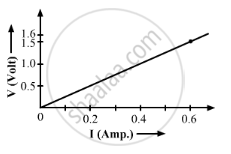Advertisements
Advertisements
Question
An electric circuit consisting of a 0.5 m long nichrome wire XY, an ammeter, a voltmeter, four cells of 1.5 V each and a plug key was set up.
Following graph was plotted between V and I values:

What would be the values of `V/I` rations when the potential difference is 0.8 V, 1.2 V and 1.6 V respectively?
What conclusion do you draw from these values?
What is the resistance of the wire?
Solution
When potential difference = 0.8 V, current = 0.32 A.
`V/I=0.8/0.32`
`V/I = 2.5`
When potential difference = 1.2 V, current = 4.8 A.
`V/I= 12/48`
`V/I=2.5`
When/ /potential difference = 1.6 V, current = 6.4 A.
`V/I= 1.6/6.4 `
`V/I =2.5`h V-I graph is a straight line with a constant slope of 2.5.
The resistance of the wire is 2.5 Ω.
APPEARS IN
RELATED QUESTIONS
Calculate the number of electrons constituting one coulomb of charge.
Three 2 V cells are connected in series and used as a battery in a circuit.
What is the p.d. at the terminals of the battery?
Which of the following equation shows the correct relationship between electrical unit?
1A = 1C/s or 1c= 1A/s
What is an electric current?
Define the following:
Semiconductors
A charge of 80 C flows in a conductor for 2 minutes.
(a) Calculate the current flowing through the conductor.
(b) If the current through a heater is 4 A what charge must be passing in 8 seconds?
A bulb is connected to a battery of p.d. 4 V and internal resistance 2.5 Ω . A steady current of 0.5 A flows through the circuit. Calculate:
The resistance of the bulb
Fill in the blank :
1 mA = ............................. A.
